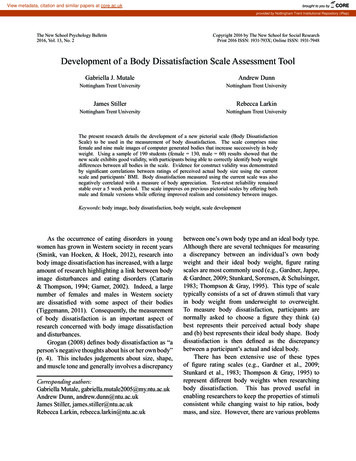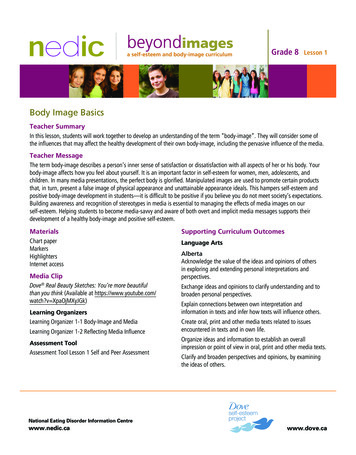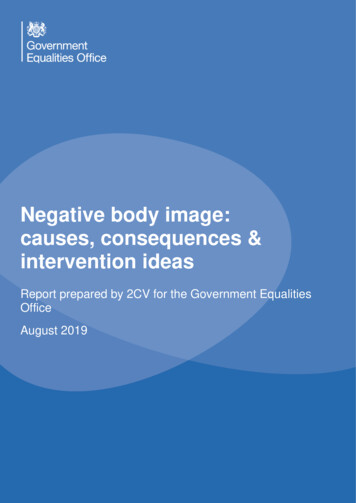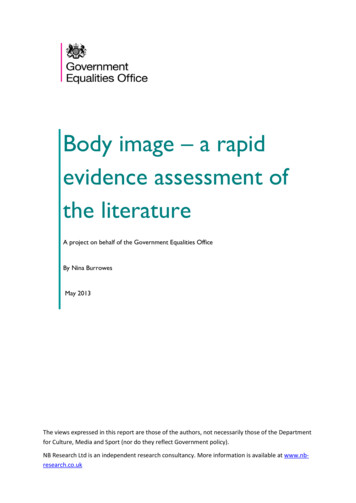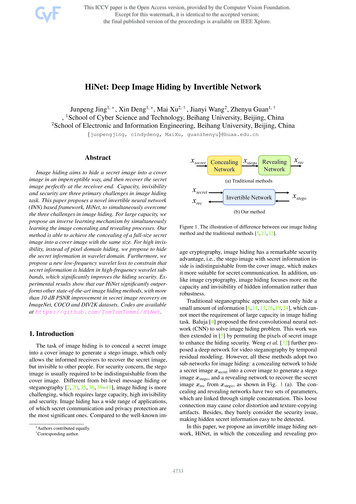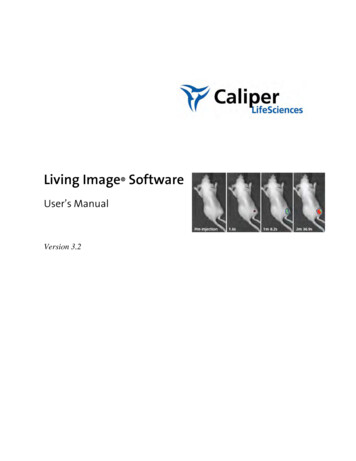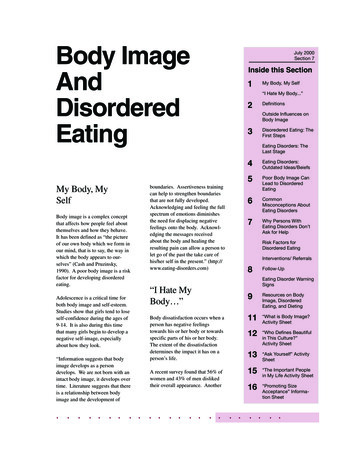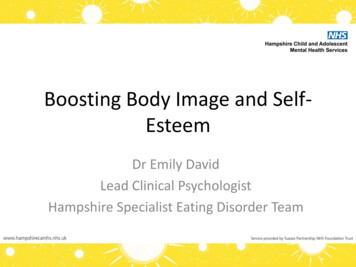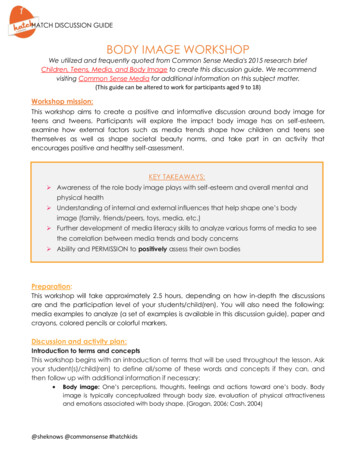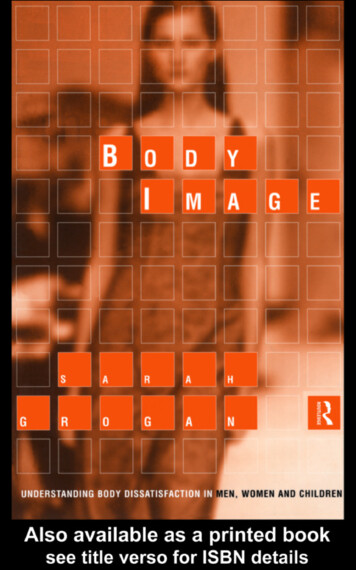
Transcription
Body ImageBody Image reviews current research on body image in men, women andchildren and presents fresh data from Britain and the United States. SarahGrogan brings together perspectives from psychology, sociology, women’sstudies and media studies to assess what we know about the socialconstruction of body image at the end of the twentieth century.Most previous work on body image concentrates on women. With themale body becoming more ‘visible’ in popular culture, researchers inpsychology and sociology have recently become more interested in men’sbody image. Sarah Grogan presents original data from interviews with men,women and children to complement existing research, and provides acomprehensive investigation of cultural influences on body image.Body Image will be of interest to students of psychology, sociology,women’s studies, men’s studies, media studies, and anyone with an interestin body image.Sarah Grogan is Senior Lecturer in Psychology at Manchester MetropolitanUniversity.
Body ImageUnderstanding bodydissatisfaction in men, womenand childrenSarah GroganLondon and New York
First published 1999by Routledge11 New Fetter Lane, London EC4P 4EESimultaneously published in the USA and Canadaby Routledge29 West 35th Street, New York, NY 10001Routledge is an imprint of the Taylor & Francis GroupThis edition published in the Taylor & Francis e-Library, 2001. 1999 Sarah GroganAll rights reserved. No part of this book may be reprinted or reproduced or utilized inany form or by any electronic, mechanical, or other means, now known or hereafterinvented, including photocopying and recording, or in any information storage orretrieval system, without permission in writing from the publishers.British Library Cataloguing in Publication DataA catalogue record for this book is available from the British LibraryLibrary of Congress Cataloging-in-Publication DataGrogan, Sarah, 1959–Body image: understanding body dissatisfaction in men, women and children / SarahGrogan.Includes bibliographical references and index.1. Body image – Social aspects – United States. 2. Body image – Social aspects – GreatBritain. I. Title.BF697.5. B63G761998155.9 1–dc2198–4036ISBNISBNISBNISBN0-415-14784-0 (hbk)0-415-14785-9 (pbk )0-203-13497-4 Master e-book ISBN0-203-17913-7 (Glassbook Format)
ContentsList of illustrationsPrefaceAcknowledgementsviiixxi1 Introduction12 Culture and body imageThe idealisation of slenderness 6The basis of body shape ideals 9Summary 2463 Women and body satisfactionAssessment of body satisfaction 26Social construction of femininity 52Summary 57254 Men and body satisfactionAssessment of body satisfaction 59Social construction of masculinity 77Summary 79585 Media effectsMedia portrayal of the body 94Mass communication models 97Recent developments 113Reducing the effects of media imagery 113Summary 11594
vi Contents6 Age, social class, ethnicity and sexualityBody image across the lifespan 117Ethnicity and body satisfaction 133Social class and body satisfaction 137Body shape, sexual attractiveness and sexuality 142Summary 1641177 Conclusions and implicationsGroups with low body satisfaction 167Development of a positive body image 179General conclusions 188Summary 192166Appendix: What causes overweight?BibliographyName indexSubject index193196211217
IllustrationsPlates1234567891011121314Rembrandt van Rijn, Bathsheba (1654)Gustave Courbet, The artist’s studio (1855)Auguste Renoir, Blonde bather (1881)Flapper fashionMarilyn MonroeTwiggyKate MossSandro Botticelli, St Sebastian (1474)Michelangelo, The Battle of Cascina (1504)Luca Signorelli, Study of two nude figures (1503)Dolph LundgrenJean-Auguste-Dominique Ingres, The Turkish bath (1863)Claudia SchifferArnold .13.24.15.16.16.26.36.47.1Female silhouette figure rating scaleFemale body shapesMale silhouette figure rating scaleEffects of viewing photographic images on body esteemFemale stimulus figures varying in WHRFemale stimulus figures varying in breast sizeMale stimulus figures varying in WHRMale stimulus figures varying in chest sizePercentage of men/women taking part in activitiesinvolving physical effort274659105147150161162186
viii Illustrations7.2Frequency of children getting out of breath and sweatyplaying games or sports in free time187Table2.1Height–weight tables for adults11
PrefaceThis book reviews current research on body image in men and women, andpresents some fresh data from interviews, questionnaires and experimentalstudies carried out recently in Britain and the United States.It is intended for students studying psychology, sociology, women’sstudies, men’s studies and media studies. It will also be useful to anyone withan interest in body satisfaction and the factors that contribute to it. It is nota text on anorexia or bulimia, although these are discussed in Chapter 7. It isprimarily designed to bring together work from disparate disciplines, alongwith some fresh research material, to assess what we know about men andwomen’s body image at the end of the twentieth century.Most previous work on body image concentrates on women. This textsummarises what we know so far about body image in men as well as inwomen. The study of male body image is a fairly recent phenomenon.Researchers in the 1980s and 1990s have started to be interested in men’sbody image largely due to the fact that the male body is becoming more‘visible’ in popular culture, leading to interest in the psychological andsociological effects of this increased exposure. This book aims to produce afresh summary of research on body image that addresses disparateperspectives within body image research, and that looks at body satisfactionand body size estimation. In particular, it presents data from qualitative andquantitative studies within psychology, sociology, cultural studies, women’sstudies and media studies, to demonstrate how they can complement eachother, and how they can lead to a better understanding of body image in menand women.Most of the data presented here come from previously published researchfrom Britain, the United States and Australia. Where there are gaps in theexisting literature, fresh data have been collected specifically for this book.
x PrefaceSome of these new data have been collected by research students in Britain(Manchester Metropolitan University) and the United States (Santa FeCommunity College) who have run interviews or administered questionnaires.It is intended that these fresh data will complement existing research to providea comprehensive investigation of cultural influences on body image.
AcknowledgementsI would like to thank all the people who have given their expertise and theirtime to make this book possible. Thanks to all those who agreed to beinterviewed or to complete questionnaires and who shared their experiencesof body dissatisfaction. Thanks to students at Manchester MetropolitanUniversity, Manchester, England (Penny Cortvriend, Lisa Bradley, HelenRichards, Debbie Mee-Perone, Clare Donaldson, Wendy Hodkinson andNicola Wainwright), and at Santa Fe Community College, Florida, USA(Jacqueline Gardner, Renee Schert, Melissa Warren, Harry Hatcher, DamienLavalee, Timothy Ford and Rhonda Blackwell), who agreed to run interviewsand administer questionnaires to their peers. I am also indebted to PaulHusband for running interviews with steroid users, and to Geoff Hunter foradvice on anabolic steroids.Thanks to colleagues, friends and family who have read various draftsand provided invaluable suggestions and support. In particular, thanks toAlan Blair, Jane Tobbell, Carol Tindall, Emma Creighton, Edward Grogan andJoanne Wren for their feedback on full and partial drafts. Thanks to MarilynBarnett for typing the body-builders’ transcripts. Thanks to Viv Ward andJon Reed for their advice during the preparation of the manuscript, and toNicholas Mirzoeff and Michael Forester for their helpful reviews.Thanks to the following for permission to include plates, figures andtables: Musée du Louvre for Plates 1 (Bathsheba), 10 (Study of two nudefigures) and 12 (The Turkish bath); Musée d’Orsay for Plate 2 (The artist’sstudio); Sterling and Francine Clark Art Institute for Plate 3 (Blonde bather);Mary Evans Picture Library for Plate 4 (Flapper fashion); Staatliche Museenzu Berlin for Plate 8 (St Sebastian); the British Museum for Plate 9 (TheBattle of Cascina); Kobal for Plates 5 (Marilyn Monroe), 11 (Dolph Lundgren)
xiiAcknowledgementsand 14 (Arnold Schwarzenegger); Retna Pictures Ltd for Plates 6 (Twiggy), 7(Kate Moss) and 13 (Claudia Schiffer); Select Press for Figures 3.2 (Femalebody shapes), 6.2 (Female stimulus figures varying in breast size) and 6.4(Male stimulus figures varying in chest size); Lippincott-Raven Publishersfor Figures 3.1 (Female silhouette figure rating scale) and 4.1 (Male silhouettefigure rating scale); the American Psychological Association for Figure 6.1(Female stimulus figures varying in WHR) and Figure 6.3 (Male stimulusfigures varying in WHR); Ashgate Publishers for Figure 7.1 (Percentage ofmen/women taking part in activities involving physical effort); the HealthEducation Authority for Figure 7.2 (Frequency of children getting out ofbreath and sweaty playing games or sports in free time); and to McGraw-Hillfor Table 2.1 (Height–weight tables for adults).Most of all, thanks to Mark Conner for reading several drafts withoutcomplaint and for consistent encouragement and support whilst I waswriting and researching this book.
1IntroductionInterest in the psychology and sociology of body image originated in thework of Paul Schilder in the 1920s. He was the first researcher to look at bodyexperience within a psychological and sociological framework. Prior toSchilder’s work, body image research was limited to the study of distortedbody perceptions caused by brain damage. Schilder developed this work toconsider the wider psychological and sociological frameworks within whichperceptions and experiences of body image took place. In The Image andAppearance of the Human Body (1950) he argues that body image is not justa cognitive construct, but also a reflection of attitudes and interactions withothers. He was interested in the ‘elasticity’ of body image, the reasons forfluctuations in perceived body size, feelings of lightness and heaviness, andthe effects of body image on interactions with others. He defined body imageas:The picture of our own body which we form in our mind, that is to say, theway in which the body appears to ourselves.(Schilder, 1950: 11)Since 1950, researchers have taken ‘body image’ to mean many differentthings, including perception of one’s own body attractiveness, body sizedistortion, perception of body boundaries, and accuracy of perception ofbodily sensations (Fisher, 1990). The definition of body image that will betaken for this book is:A person’s perceptions, thoughts and feelings about his or her body.This definition incorporates all the elements of body image originally identifiedby Schilder: body size estimation (perceptions), evaluation of bodyattractiveness (thoughts), and emotions associated with body shape and
2Introductionsize (feelings); and is adapted from a definition produced by Thomas Pruzinskyand Thomas Cash (1990). Body dissatisfaction is defined here as:A person’s negative thoughts and feelings about his or her body.In recent years, there has been a noticeable increase in academic andpopular interest in body image. The sociology of the body has become anestablished discipline in the 1990s, with Bryan Turner (1992) coining the term‘somatic society’ to describe the new-found importance of the body incontemporary sociology. The popularity of Mike Featherstone and BryanTurner’s journal Body and Society, set up in Britain in the mid-1990s,demonstrates the high level of interest in the role of the body in social theory.Psychologists have also become more interested in the psychology of bodyimage, with an increase in research into psychological factors predictingbody satisfaction. Newspapers and magazines in Britain and the United Statesare replete with stories about plastic surgery, ‘eating disorders’, reducingdiets (and the dangers of dieting), and critiques of the use of skinny modelsto advertise products (often placed adjacent to pictures of skinny models inadvertisements!). The end of the twentieth century is clearly a time of enhancedconcern with body image.In this book, body image will be investigated from psychological andsociological viewpoints. This is because body image is a psychologicalphenomenon which is significantly affected by social factors. To understandit fully, we need to look not only at the experiences of individuals in relationto their bodies, but also at the cultural milieu in which the individual operates.Only by investigating the psychology and sociology of the body will it bepossible to produce an explanation of body image that recognises theinteraction between individual and societal factors.Body image is conceptualised here as subjective, and open to changethrough social influence. There is no necessary link between a person’ssubjective experience of their body and what is perceived by the outsideobserver. This is obvious in distortion of body size (e.g. many young womenwho experience anorexia nervosa believe they are much heavier than theyreally are), and in cases of ‘phantom limb’ phenomena (in which people whohave had limbs amputated report still ‘feeling’ the missing limb). It is alsorelevant (though less obvious) in the large number of women and girls who‘feel fat’, although they are objectively of average (or below average) weightfor their height; and in men who feel too thin or too fat although they areobjectively of average size.
Introduction3The image that an individual has of his or her body is also largely determinedby social experience. Body image is elastic and open to change through newinformation. Media imagery may be particularly important in producingchanges in the ways that the body is perceived and evaluated, depending onthe viewer’s perception of the importance of those cues. It is likely that someviewers are more sensitive to such cues than others. For instance, it has beensuggested that adolescents are especially vulnerable because their bodyimage is particularly ‘elastic’ while they undergo the significant physical andpsychological changes of puberty. Other groups who attach particularimportance to body-related imagery (e.g. people with eating disorders, bodybuilders) may also be sensitised to media cues. Research has suggested thatmost people have some reference group that furnishes social informationrelevant to body image (which may be friends, family or the media). Bodyimage is socially constructed, so it must be investigated and analysed withinits cultural context.This book investigates men’s and women’s body image, focusing inparticular on cultural influences on body image, and on degree of bodysatisfaction and dissatisfaction in men and women of different ages. Theoryand data from psychology, sociology, women’s studies and media studies areintegrated to address the question of how men and women experience bodyshape and weight. It will be argued that body dissatisfaction is normative inwomen in the Western world from eight years of age upwards, and that thishas a significant impact on behaviour such that most women try to changetheir shape and weight, and many women avoid activities that would involveexposing their bodies. Body image in men will also be investigated. Datashow that boys from as young as eight years old also show concern overbeing the ‘right’ shape, and many adult men’s self-esteem is related to howgood they feel about their body shape.Chapter 2 reviews current research on culture and body image. It is arguedthat Western culture prescribes a narrow range of body shapes as acceptablefor men and women, and that those whose body shape and size falls outsidethis range may encounter prejudice, especially if they are heavier than isculturally acceptable. The debate as to the basis for current Western culturalideals is reviewed. Arguments from the biological determinist perspective(suggesting a biological basis for body shape preferences), and from socialpsychology and sociology (stressing cultural relativity), are evaluated. Anhistorical review of trends during this century shows how cultural ideas ofacceptable body shape have changed radically over the years, particularlyfor women. Myths about weight and health are questioned, and the impact ofthe dieting industry on the lives of men and women is examined. Chapter 2
4Introductionprovides a backdrop for the data on body dissatisfaction presented inChapters 3, 4, 5 and 6, demonstrating the extent of socio-cultural pressures inWestern society.Chapter 3 looks specifically at body dissatisfaction in women. Differenttechniques that have been used to assess satisfaction are evaluated, alongwith findings based on each technique, to determine the extent of bodydissatisfaction and the reasons why women are dissatisfied. Women’sattempts to modify their bodies through plastic surgery, dieting, exercise andbody-building are investigated, reflecting on data from psychology, sociologyand women’s studies. The chapter ends with a review of cultural pressureson women to conform to the socially acceptable ‘slim but shapely’ bodyshape, drawing mostly on work from contemporary feminist writers on thesocial construction of femininity.Chapter 4 focuses on body satisfaction in men. Most previous work onbody satisfaction has focused on women. A review of men’s body satisfactionis timely in the light of recent arguments that there has been a cultural shift inthe 1980s and 1990s such that men are under increased social pressure to beslender and muscular. Men’s satisfaction is evaluated, using work fromsociology and psychology and introducing fresh data from interviews withyoung men, to determine whether men seem to be aware of societal pressures,and whether these pressures impact on their body satisfaction. Current workon body-building and anabolic steroid use is reviewed, to understand thepsychological and social effects of becoming more muscular, and themotivations behind taking anabolic steroids in spite of negative side effects.Work on the social construction of masculinity is reviewed, to produce apicture of social pressures on men, and to evaluate the extent of recent culturalchanges on men’s acceptance of their body shape and size.Chapter 5 looks directly at studies of the effects of media pressure. Theoryand data from psychology, sociology and media studies are discussed inrelation to effects of exposure to idealised media images of attractivephotographic models. Content analyses of media portrayal of the male andfemale body are reviewed. Mass Communication Models are then evaluated,with reference to ‘Effects’ and ‘Uses and Gratifications’ models. Empiricalevidence of the direct effects of observing media imagery is reviewed andevaluated, with special reference to two of the most influential psychologicaltheories in this area: Social Comparison Theory and Self Schema Theory.Data from laboratory experiments are complemented by data from interviewsto evaluate the mechanisms through which media role models may affectbody satisfaction in men and women. Recent developments are discussed, inwhich representatives of various media have reflected on the use of slender
Introduction5models, along with ideas for reducing the effects of media imagery based oncurrent psychological and sociological theories.Chapter 6 investigates the effects of age, ethnicity, social class and sexualityon body satisfaction. Questionnaire studies which have charted changes insatisfaction throughout the lifespan are discussed, along with relevant datafrom interviews carried out with children and adolescents specifically for thisbook. Dissatisfaction is identified in the accounts provided by children asyoung as eight years old, and reasons for this dissatisfaction are discussed.There is discussion of ethnicity and body dissatisfaction, evaluating claimsthat black women are more satisfied with their body shape and size in thecontext of a sub-culture where plumpness may be perceived as attractive anderotic. Social class differences in body satisfaction are discussed within asocial context that associates slenderness with the middle and upper classes,especially for women. The historical link between slenderness and socialclass is explored. Finally, differences in body satisfaction in heterosexual menand women, gay men and lesbians will be investigated. Research fromsociology and psychology, looking at different sub-cultural pressures, willbe investigated, and this section will include an evaluation of evidencesuggesting that the lesbian sub-culture protects against body dissatisfaction.In the concluding chapter, arguments presented in the earlier chapters willbe summarised, with an exploration of their implications. This chapter aims tosummarise factors that seem to predict either dissatisfaction or satisfactionwith the body, to try to identify ways to counter social pressures and developpositive body images through raising self-esteem and perceptions of controlover the body, and by developing images of the body based on functionrather than on aesthetics.
2Culture and body imageThis chapter explores the effects of cultural influences on body image. Culturalprejudice in favour of slenderness and against overweight is placed in apsychological and sociological context, with a critical evaluation of the rolesof biology and culture in promoting the slim ideal.The idealisation of slendernessIn affluent Western societies, slenderness is generally associated withhappiness, success, youthfulness and social acceptability. Being overweightis linked to laziness, lack of will power and being out of control. For women,the ideal body is slim. For men, the ideal is slender and moderately muscular.Non-conformity to the slender ideal has a variety of negative socialconsequences. Overweight (for both men and women) is seen as physicallyunattractive and is also associated with other negative characteristics.Tracing the social meanings attached to slimness over the years, SusanBordo (1993) shows how, starting at the end of the last century, excess flesh(for men and women) came to be linked with low morality, reflecting personalinadequacy or lack of will. This has continued into the 1990s, where theoutward appearance of the body is seen as a symbol of personal order ordisorder. Slenderness symbolises being in control. The muscled body hasrecently lost its associations with manual labour and has become anothersymbol of will power, energy and control. The firm, toned body is seen asrepresenting success. Most people do not have slim, toned bodies naturally,so they have to be constantly vigilant (through exercise and diet) so as toconform to current ideals. Bordo argues that the key issue in the currentidealisation of slenderness is that the body is kept under control:
Culture and body image7The ideal here is of a body that is absolutely tight, contained, bolteddown, firm.(Bordo, 1993: 190)This links the spare, thin, feminine ideal with the solid, muscular, masculineideal, since both require the eradication of loose flesh and both emphasisefirmness.People who do not conform to the slender ideal face prejudice throughouttheir lifespan. Thomas Cash (1990) argues that overweight people are treateddifferently from childhood. Children prefer not to play with their overweightpeers, and assign negative adjectives to drawings of overweight people.This prejudice continues into adulthood, when overweight people tend to berated as less active, intelligent, hardworking, successful, athletic and popularthan slim people. People who are overweight are likely to find more difficultyrenting property, being accepted in ‘good’ United States colleges and gettingjobs, than are their slimmer peers.In an interesting psychology study by Marika Tiggemann and EstherRothblum (1988), large groups of American and Australian college studentswere asked about their stereotypes of fat and thin men and women. Theywere asked to rate the extent to which eight qualities were typical of thin menand women and fat men and women. Men and women in both cultures reportednegative stereotypes of fat people. Although fat people were seen as warmerand friendlier, confirming the traditional stereotype of the fat and jolly person,they were also viewed as less happy, more self-indulgent, less self-confident,less self-disciplined, lazier and less attractive than thin people. Thesedifferences were more marked for judgements of fat women than fat men. Theresults indicate negative stereotyping of fat people, especially fat women, inthese college students (Tiggemann and Rothblum, 1988). What wasparticularly interesting was that there were no differences in stereotypingbetween students who were fat and those who were thin. Even those whowere overweight had negative stereotypes of fat people.The tendency to link physical attractiveness with positive personal qualitieshas been documented since the 1970s, when Dion and colleagues coined thephrase ‘What is beautiful is good’ (Dion et al., 1972: 285). They suggestedthat people tend to assign more favourable personality traits and life outcomesto those that they perceive as attractive. In an updated review of evidence inthis area, Alice Eagley and colleagues (1991) suggest that the effects of thephysical attractiveness stereotype are strongest for perceptions of socialcompetence (sociability and popularity). Negative stereotyping of overweight
8Culture and body imagepeople may be a specific aspect of the physical attractiveness stereotypethat refers specifically to assignment of negative traits to those who have abody size and shape that is not considered attractive by dominant groups inWestern culture.It is likely that causal attributions affect responses to overweight people.If overweight is seen as being caused by factors within the individual’s control(through overeating, lack of exercise) then overweight people are more likelyto be stigmatised. Christian Crandall and Rebecca Martinez (1996) comparedattitudes to being overweight among students from the United States andMexico. The United States was chosen because it has been considered to bethe most individualistic culture in the world (Hofstede, 1980). That is, USculture (in general) values independence, and tends to perceive individualsas responsible for their own fates. Mexico, on the other hand, was ratedthirty-second out of the fifty-three countries rated for individualism byHofstede, and is generally perceived to be a culture that emphasisesinterdependence and connection, with more focus on external, culturalinfluences on behaviour. Crandall and Martinez predicted that Mexicanstudents would be less likely to see being overweight as within an individual’scontrol, and less likely to stigmatise someone for being overweight. Theysupported both these hypotheses, finding that anti-fat attitudes were lessprevalent amongst Mexican students and that Mexican students were lesslikely to believe that weight gain is under personal control. US participantswere more likely to agree that fat people have little will power and that beingfat is their own fault. Crandall and Martinez argue that anti-fat attitudes arepart of an individualistic Western ideology that holds individuals responsiblefor their life outcomes.The Crandall and Martinez study is typical of others in the literature, sinceit stresses that prejudice against overweight is culturally bound and dependson attribution of blame. Within Western ideology, being overweight isperceived to violate the cultural ideal of self-denial and self-control. In fact,there is a growing body of evidence suggesting that overweight results, atleast in part, from genetic factors (Stunkard et al., 1990; see Appendix).However, people still tend to hold on to the erroneous belief that the individualis ‘to blame’ for increased body weight because it fits ideological beliefs ofpersonal responsibility. This results in prejudice against people who do notconform to the slender cultural ideal.
Culture and body image9The basis of body shape idealsThere is an ongoing debate about the reasons why Western culture shows apreference for slenderness. On the one hand, biologists and somepsychologists have suggested that these body shape preferences derivefrom biology. They argue that these ideals are based on the fact thatslenderness is more healthy than overweight. On the other hand, theoristswho have looked at cultural differences in body shape preferences at differenttimes and in different cultures have tended to suggest that biology plays aminor role in the idealisation of slenderness, and that it is largely learned.These two views will be evaluated here.Body weight and healthBiological arguments stress the importance of slenderness for health (andthe unhealthiness of overweight). Slenderness has not always been linkedwith health. At the start of the twentieth century, thinness was associatedwith illness in the United States and in Britain, because of its link withtuberculosis (Bennett and Gurin, 1982). More recently, extreme thinness iscoming to be associated with AIDS. Indeed, AIDS is known as ‘slim’ in someAfrican countries. The cultural effects of this association between thinnessand illness in Western industrialised countries may become apparent overthe next decade, but at present thinness does not produce the generallynegative stereotypes that are found in poorer nations. Instead, there is ageneral belief that to be plump is unhealthy, and that thinness is an indicatorof good health.In order to determine the health risks of overweight, it is important to drawa distinction between mild
A catalogue record for this book is available from the British Library Library of Congress Cataloging-in-Publication Data Grogan, Sarah, 1959- Body image: understanding body dissatisfaction in men, women and children / Sarah Grogan. Includes bibliographical references and index. 1. Body image - Social aspects - United States. 2.
